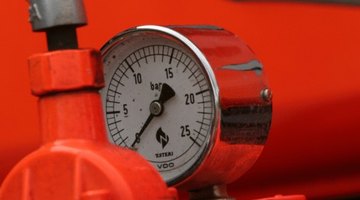Parts of a Pressure Gauge
Table of Contents
Pressure measurement is used in everyday modern living. It is typically found in activities such as checking tires in a gas station, reading the water pressure level in a pressure tank, and checking blood pressure during a routine visit to the doctor.

There are people who wonder how pressure gauges actually work, and a lot of it has to do with the individual components that make up the device.
Case
The case holds all the moving parts of the pressure gauge in one place and protects the components from damage. Cases can be made out of a variety of materials, depending on the demands of the application. For industrial applications, the cases have to be made of more rugged material, such as polypropylene or stainless steel, while commercial applications may only require steel or aluminum cases.
Bourdon Tube
The Bourdon tube is one of the most important parts of a pressure gauge, as it is the means by which a gauge can detect pressure. Also known as the sensing element, the Bourdon tube flexes when it is subjected to pressure. The motion that results is then transmitted to the pointer. The materials that make up the Bourdon tube are dependent on the pressure medium that it receives. A bronze or brass Bourdon tube is satisfactory for pressure gauges that receive air, gas, steam, water and other noncorrosive media. For pressure gauges designed to handle corrosive media or media that can easily solidify or can deposit solids, a diaphragm seal is included to protect the Bourdon tube.
Linkage
As its name suggests, the linkage connects the Bourdon tube to the gear mechanism. As the Bourdon tube flexes on application of pressure, the linkage transmits the movement of the Bourdon tube to the gear mechanism to activate the gears.
Gear Mechanism
The gear mechanism is the recipient of the movement from the Bourdon tube and the linkage, and it is the part that controls the movement of the pointer. Each gear in a pressure gauge gear mechanism is precision-built in order to move the pointer accurately. The required ANSI accuracy rating for a particular pressure gauge ultimately determines how the gear mechanism is designed. Pressure gauges that read finer increments of pressure require more-complex gear mechanisms.
Pointer, Dial Face, Window and Ring
The pointer is the visible part of the pressure gauge you see moving when pressure is being measured. It "reads" measurements as it points to value gradations or increments on the dial face. This part is directly connected to and controlled by the gear mechanism to indicate pressure within the ANSI accuracy rating of the gauge. The dial face contains the different pressure measurements. Dial faces can have gradations in kilogram force per square centimeter format, pound force per square inch, standard atmosphere, torr (mmHg) and other units of pressure. The window is made out of clear plastic or glass. It serves as a protection for the pointer and the dial face, and it provides a means by which you can view pressure readings.
The Drip Cap
- Pressure measurement is used in everyday modern living.
- The Bourdon tube is one of the most important parts of a pressure gauge, as it is the means by which a gauge can detect pressure.
- The materials that make up the Bourdon tube are dependent on the pressure medium that it receives.
- A bronze or brass Bourdon tube is satisfactory for pressure gauges that receive air, gas, steam, water and other noncorrosive media.
- The pointer is the visible part of the pressure gauge you see moving when pressure is being measured.
- The dial face contains the different pressure measurements.
References
Photo Credits
- Jupiterimages/Photos.com/Getty Images
- Jupiterimages/Photos.com/Getty Images
More Articles



